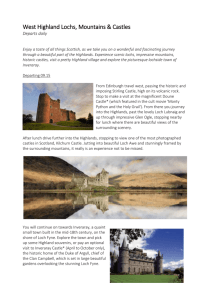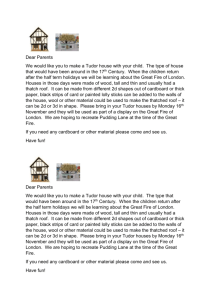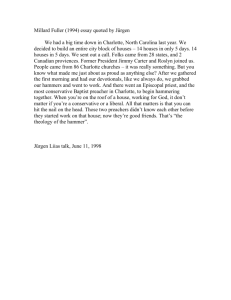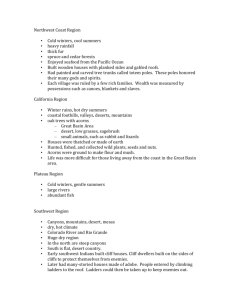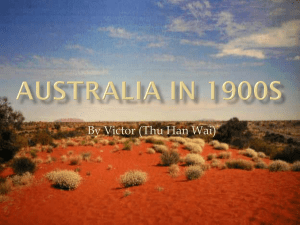This walk is 4 miles, distance in km mostly along paved roads and
advertisement
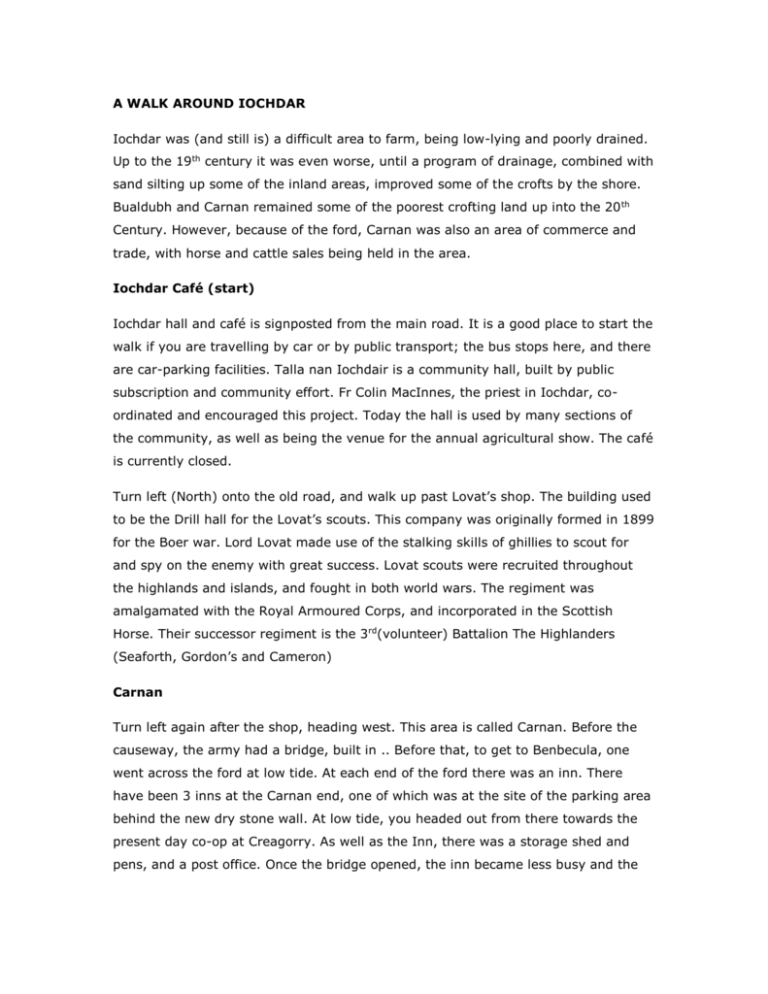
A WALK AROUND IOCHDAR Iochdar was (and still is) a difficult area to farm, being low-lying and poorly drained. Up to the 19th century it was even worse, until a program of drainage, combined with sand silting up some of the inland areas, improved some of the crofts by the shore. Bualdubh and Carnan remained some of the poorest crofting land up into the 20 th Century. However, because of the ford, Carnan was also an area of commerce and trade, with horse and cattle sales being held in the area. Iochdar Café (start) Iochdar hall and café is signposted from the main road. It is a good place to start the walk if you are travelling by car or by public transport; the bus stops here, and there are car-parking facilities. Talla nan Iochdair is a community hall, built by public subscription and community effort. Fr Colin MacInnes, the priest in Iochdar, coordinated and encouraged this project. Today the hall is used by many sections of the community, as well as being the venue for the annual agricultural show. The café is currently closed. Turn left (North) onto the old road, and walk up past Lovat’s shop. The building used to be the Drill hall for the Lovat’s scouts. This company was originally formed in 1899 for the Boer war. Lord Lovat made use of the stalking skills of ghillies to scout for and spy on the enemy with great success. Lovat scouts were recruited throughout the highlands and islands, and fought in both world wars. The regiment was amalgamated with the Royal Armoured Corps, and incorporated in the Scottish Horse. Their successor regiment is the 3rd(volunteer) Battalion The Highlanders (Seaforth, Gordon’s and Cameron) Carnan Turn left again after the shop, heading west. This area is called Carnan. Before the causeway, the army had a bridge, built in .. Before that, to get to Benbecula, one went across the ford at low tide. At each end of the ford there was an inn. There have been 3 inns at the Carnan end, one of which was at the site of the parking area behind the new dry stone wall. At low tide, you headed out from there towards the present day co-op at Creagorry. As well as the Inn, there was a storage shed and pens, and a post office. Once the bridge opened, the inn became less busy and the chief business was the post-office. Later, the Inn was destroyed by fire, and the post office moved to within Iochdar. Note the old thatched house by the shore a little way along the road. This is one of the few thatched houses that are still inhabited. Most thatched houses that are still standing were built between the 1870’s and the 1920’s, although this is older. This house was the other inn at Carnan. At high tide, a boat sailed between here and the jetty behind the current co-op in Creagorry. It ceased to be an inn after it lost its licence following a fight, and was superseded by the post office and inn at the bridge end. At the time of writing, Eriskay ponies are grazed in the fields around this house. These are a distinctive local breed of small ponies that were used as small draft animals. They are very sturdy and are good riding ponies. This stretch of road, along the Carnan area, used to support quite a large population, mostly of cottars, people without crofts or land of their own. Many were displaced from other areas. Carnan is not easy land to farm, being very boggy and salty, with a poor supply of water. There are many deserted houses on both sides of the roads; some are quite substantial traditional houses. Many people left for the Americas in the 1920s following the First World War, on 2 boats, called the ‘Metagama’, and the ‘Marloch’. The emigration ships started their voyage in Lewis, and picked up people at a number of ports throughout the Western Isles. Soldiers who fought in the First World War were promised ‘land fit for heroes’, but the reality was very different when they returned home. In some instances, land was taken by force from returning servicemen. To the right of the road, by the last house, there are several interesting things to see. There is a large island, accessible at low tide, which is in use for crofting. This is marked on the OS map as Eilean Cuidhe nam Fiadh or ‘ the island of the deer enclosure’. It is also known locally as ‘Eilean nan Lochlannaich’ as are the two rocky islands further out towards Benbecula. This name translates as ‘Islands of the Norse’. Interestingly, in Viking times, Benbecula, Iochdar and these islands were all connected by dry land; these mounds may have been settled areas. In other parts of the Uist machair, Viking settlements are usually higher than the surrounding land. There are several unexcavated duns and settlements further along the machair in Iochdar. The road is raised up above the surrounding land at this point, and there are old sluice gates to allow the water to be controlled. The man who controlled the sluice gate had a tied cottage in this area. Just along from the sluice gate, the mudflats support a small colony of samphire. Almost opposite, it is possible to make out a very boggy track leading into the centre of Iochdar. This area had very little fresh water, and this track was intended for cattle, taking them in to a fresh water loch. The track is now all but impassable, with poor drainage, and many new fences crossing it. Gualan The road deteriorates as it starts to swing round to the south. The long island dune to the west is called the Gualan, accessible at low tide. It is a site for nesting birds, which should not be disturbed during the breeding season, as gulls can raid nests when the adult birds have been scared away. At low tide, large areas of sand in the ford and around the Gualan provide feeding grounds for many birds. For example, last year the following birds were seen regularly: Shelduck, Teal, Tufted duck, redbreasted merganser, ringed plover, golden plover, lapwings, oystercatchers, turnstones and dunlin, as well as many rarer species. The duck prefer the area beyond Hebridean Jewellery, where there is always water. The mud flats support rich colonies of seas asters and thrift. The shop on the left of the road is Hebridean Jewellery. You may wish to call in for a coffee, and to see the wide range of jewellery and gifts, as well as CDs and books about the islands. After the shop, to your left, lies some land that is used to grow fodder in strips, on a rotational basis. The corn that is grown is usually Bere, which is like barley, or a mixture of bere and oats. The grain is not threshed, but harvested and stored whole, as winter fodder for cattle. In autumn, you may see traditional stacks of corn standing in the fields. This croft is part of an environmentally sensitive area. Just before Hebridean jewellery, look out for a collection of old buildings next to a 1 ½ storey house. The largest of these was the first inn in Iochdar, and is over 300yrs old. The main road down the islands at that time came up the machair, through the township, and then along through Carnan to the ford; you are on the old main road. Next, the road runs onto a short causeway and bridge. Not many years ago, the stretch of water under the bridge remained sandy shore, with flounders. It has now started to silt up, and has become part of a larger brackish loch. The sea flows into the loch at very high tides only. In the 1970’s, and again in 2005, there were floods, the sea being driven inland by hurricane-force winds. The water reached to door of the large 1 ½ storey house to your left. At the junction, turn left, and start to walk back through Iochdar. On the right of the road, immediately after the junction, if you look closely, there is an evenly domed raised area. This is a well-preserved broch or dun, in the centre of a wet bit of land that is an environmentally sensitive area, because of the number of bog plants that are found there. Brochs are large and defensive stone structures. There is a wellpreserved example in Carloway in Lewis. They date from around 400BC to AD200, although some were occupied for much longer. Two swans nest each year on the loch to your left. They have been dubbed Romeo and Juliet. If you are very sharp-eyed, you may see a few bright green tussocks along the shore of this loch, indicating areas where otters spraint. Take time to look at the wild flowers along this stretch. On the verges you may find Bistort, several varieties of Marsh Orchid, knot grass, shepherd’s purse, sandwort, stitchwort, chickweed, yarrow, marsh marigold, cuckoo flower, silverweed, campanula and many more. Opposite the loch, the 1-½ storey house had a busy shop in the small building by the gate. When the tweed mill was open, the workers, as well as passing school pupils created quite a passing trade Bualdubh The old school is a large white building on the left side, after the loch. It was built in 1875, and was in use up to 1962. This is built in a characteristic style for Island schools, with the schoolhouse being a slightly later addition. It is currently a private residence. The large schoolroom was the venue for many dances and weddings. It went out of use when the new school opened. Many of the single-teacher schools in the area closed at the same time. Immediately after the old school is a builder’s yard. The two sheds used to provide employment for many local residents, as they were once a woollen mill, where Harris Tweed was woven on looms. The mills were set up by a company in Oban. The buildings were later the venue for many local dances before the hall was built. It was grandly referred to as ‘The Pavilion’. The shrine a little further along the road is to Mary. It is a very good example of the shrines to be found throughout the North end of South Uist. Father ‘Rocket’, as Cannon John Morrison was known, erected these shrines to Mary throughout his parish, mostly at road junctions. People in the township maintain them, and this shrine is particularly well cared for. The Cannon was also responsible for the large statue of Mary, Our Lady of the Isles, below the range control buildings on Rueval. It is very unusual to find roadside shrines in the British Isles, outside some areas of the Republic of Eire. The townships within Iochdar number 12 at present, each representing an organisational group for deciding about how to use the grazings and other areas of land. Some townships may now only consist of 2 households. The area at this point is called Bualdubh. The crofts here lie in traditional narrow strips crossing the road. These strips allow each crofter to have an equal allocation of different types of land. Because most crofts are too small to be profitably farmed, crofters often have another job, or sublet other crofts to increase the land that they can use. The small scale, low profit nature of crofting means that the environment has not generally been sacrificed for short-term gains. Look for houses for differing time periods on a single croft; you can see examples of the old thatched houses beside 1 1/2 storey houses, which are generally mid 20th century. Newer houses are often bungalows. The stone thatched houses must have contrasted strangely with the large slate-roofed school and house when they were built, with fires and chimneys in every room. The only other slated buildings would have been the churches, so the school would have seemed very grand indeed. The taighean tugha (thatched houses) are generally very low-lying, rectangular buildings, with thick double skinned walls insulated in the centre with soil. The construction means that wind resistance is reduced, and the houses are very snug. The roof timbers are generally made of any suitable material to hand, covered with turf and thatched with marram grass, held down with net and ropes weighted with stones. After the 1920s, government sponsored reforms changed the traditional building methods to include mortar and slates. There are 2 old thatched houses together on the right just before the school playing fields. The one closest to the road used to be studded with shells, and behind it, the derelict house used to be a museum. Cannon John Morrison collected the material in the museum, during the period of rapid social change after the Second World War. The old lifestyle was rapidly overtaken by the 20th century, a change that seems to have been accelerated as a result of the influx of military staff during the 2 nd world war, and as a consequence of the presence of the rocket range. The collection was gifted to the South Uist Historical society, and is now in the museum at Kildonan. As well as reconstructions of the interior of an old croft, there are displays on the working lives of crofters, including working the land, weaving, and fishing. White city Carry on through ‘white city’, to Rubha Doigeag; these council houses were the first to be built in this area, and were painted white. The incredible contrast to the old stone houses was obviously worthy of comment. The grazings around here are shared by the crofters of Bualdubh, and some of the land is now fenced. In the past, Iochdar was an area where a lot of highland cattle were kept; there were no sheep until recently. The unfenced land meant that drovers, who could be anyone from the township, watched the cattle. From in front of the council houses, and looking across the loch on your left (Loch nan Ceann), you can make out the ridges of lazy beds, where crofters planted potatoes into ridges formed from seaweed covered in turf. Loch nan Ceann is a focus for lots of wildlife, including moorhen, whooper and mute swans, diving ducks and otters. The moorhen are particularly unusual for the Uists. Recent tree planting of native species has enhanced the range of habitats around the loch. After the kink in the road, there is a ruined old house; this was the residence of the smith. His smithy was across the track on the small raised area. There were smiths scattered up and down the islands until tractors took over from horses in the 1950’s. In many cases, the smithies have been on the same site for centuries. After the 1745 rebellion, it was decreed that the smith’s house should lie away from the rest of the township, to discourage people from gathering together and plotting further insurrection. The roof-timbers of this house are riddled with shipworm, showing that it is probably wood from an old boat, or even driftwood. There is a small short cut through the long grass onto the old road to your left. Follow this and continue back towards the Hall. To your right, over the new road, is another shrine. Behind this is an enclosure, of unknown age, rectangular, with its long western wall cutting across the whole promontory. The return to the hall signifies the end of the walk.

